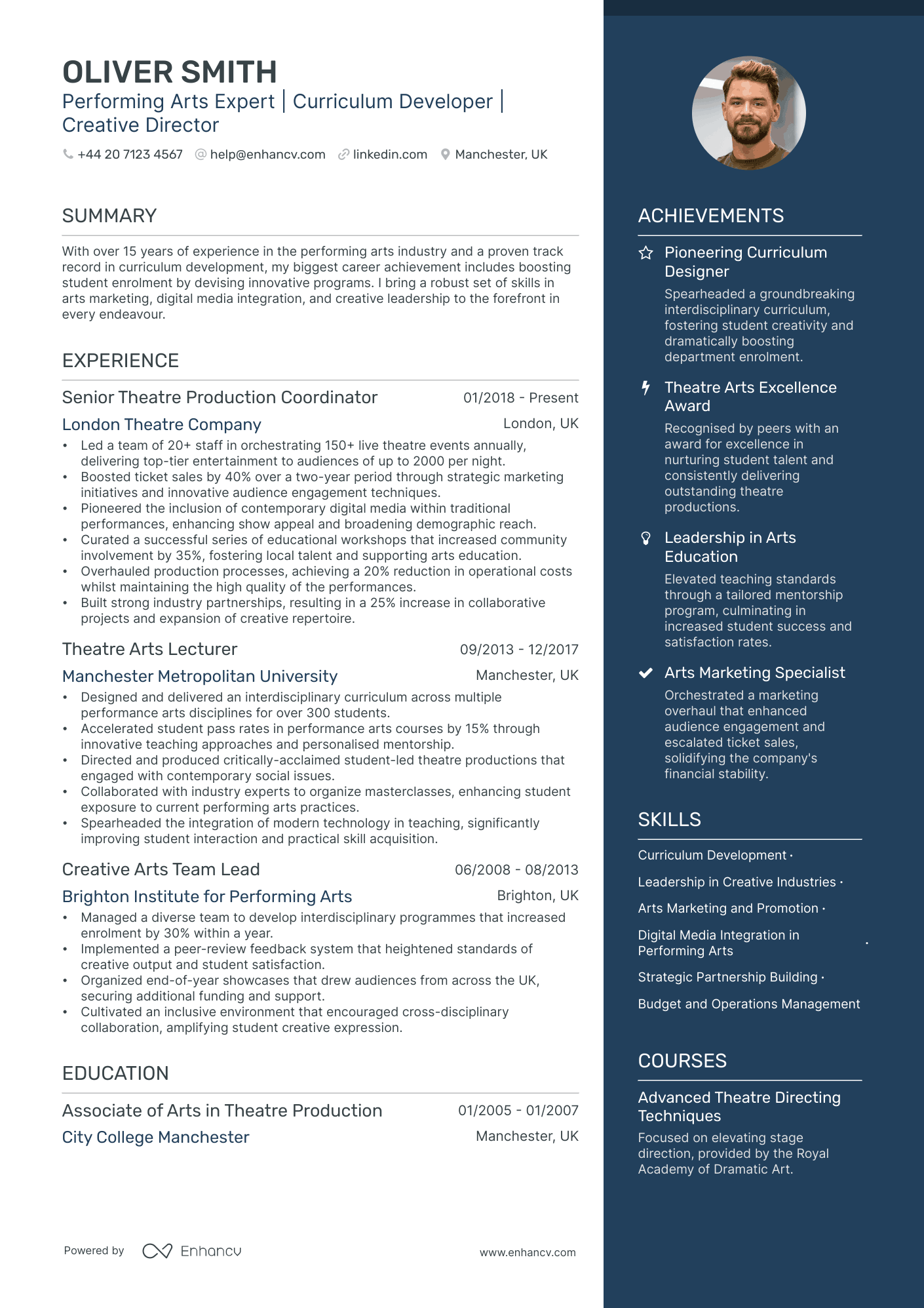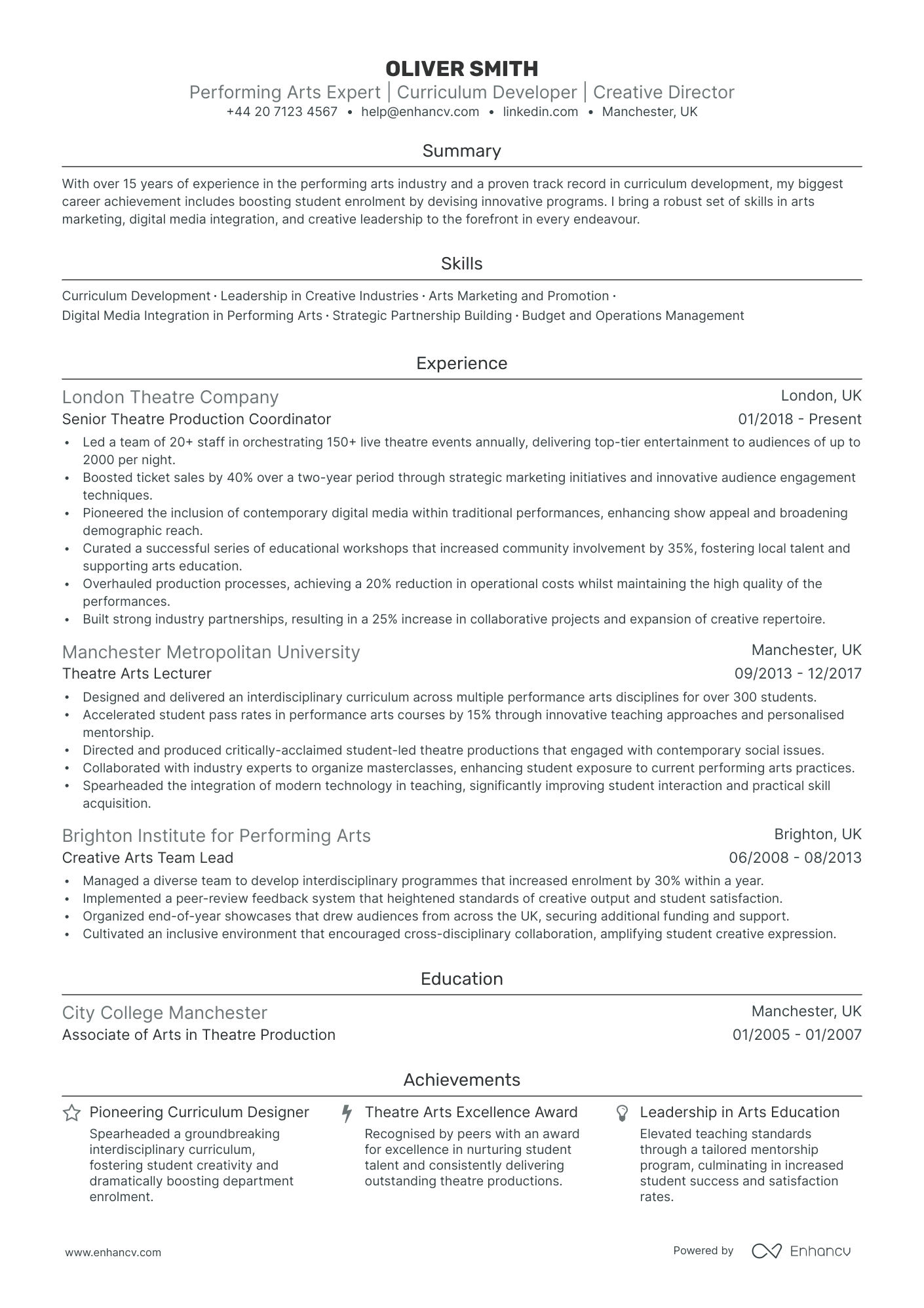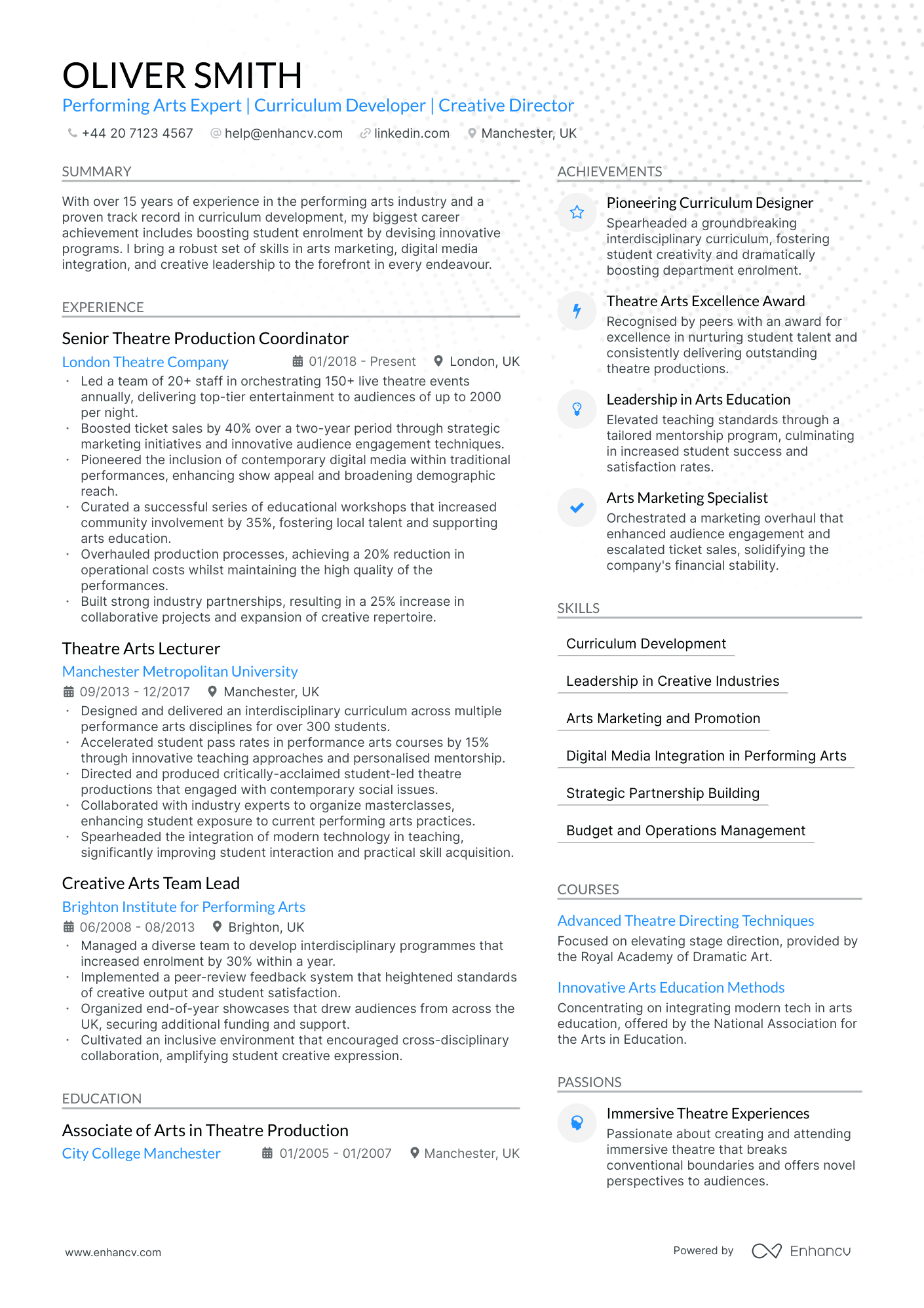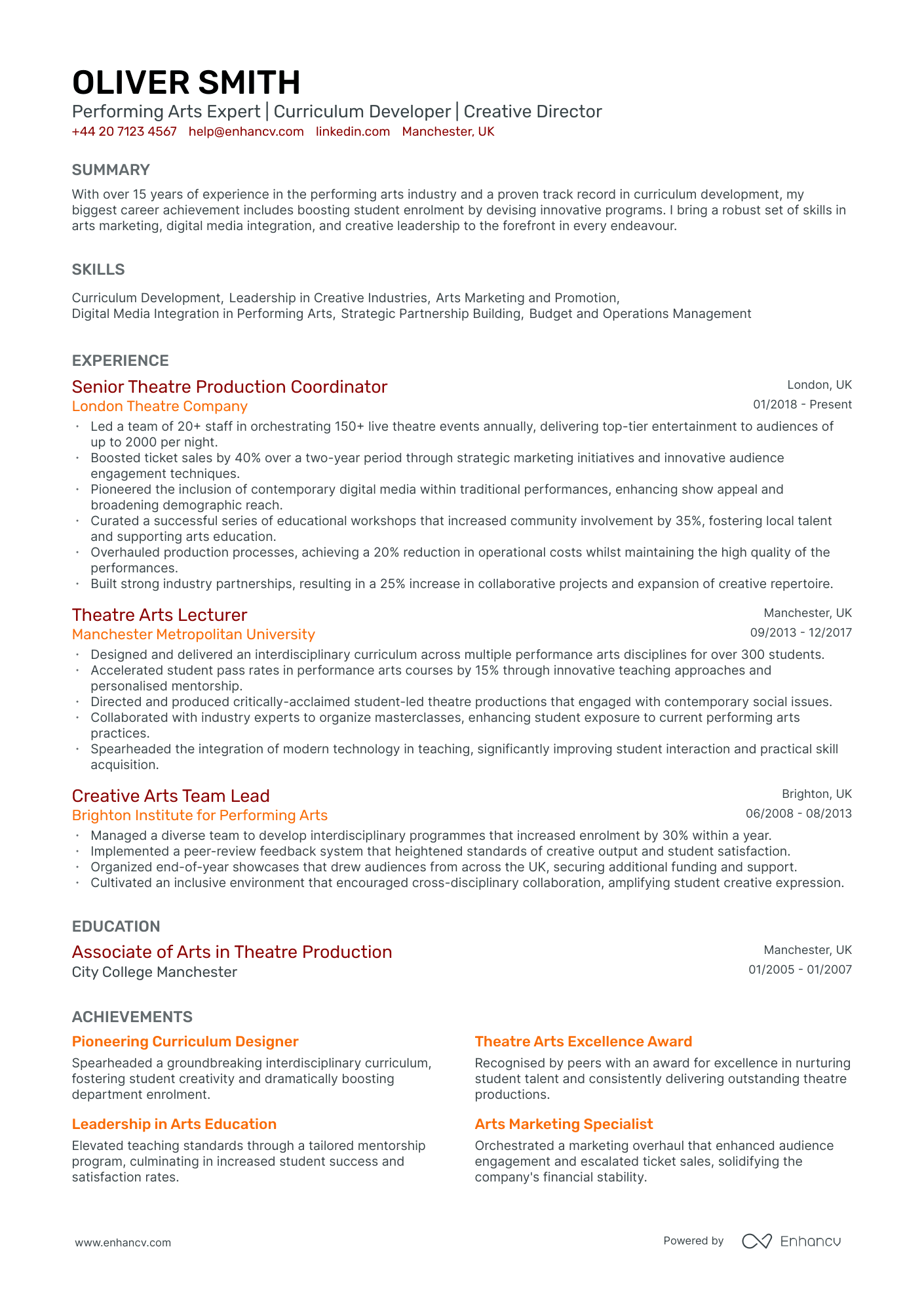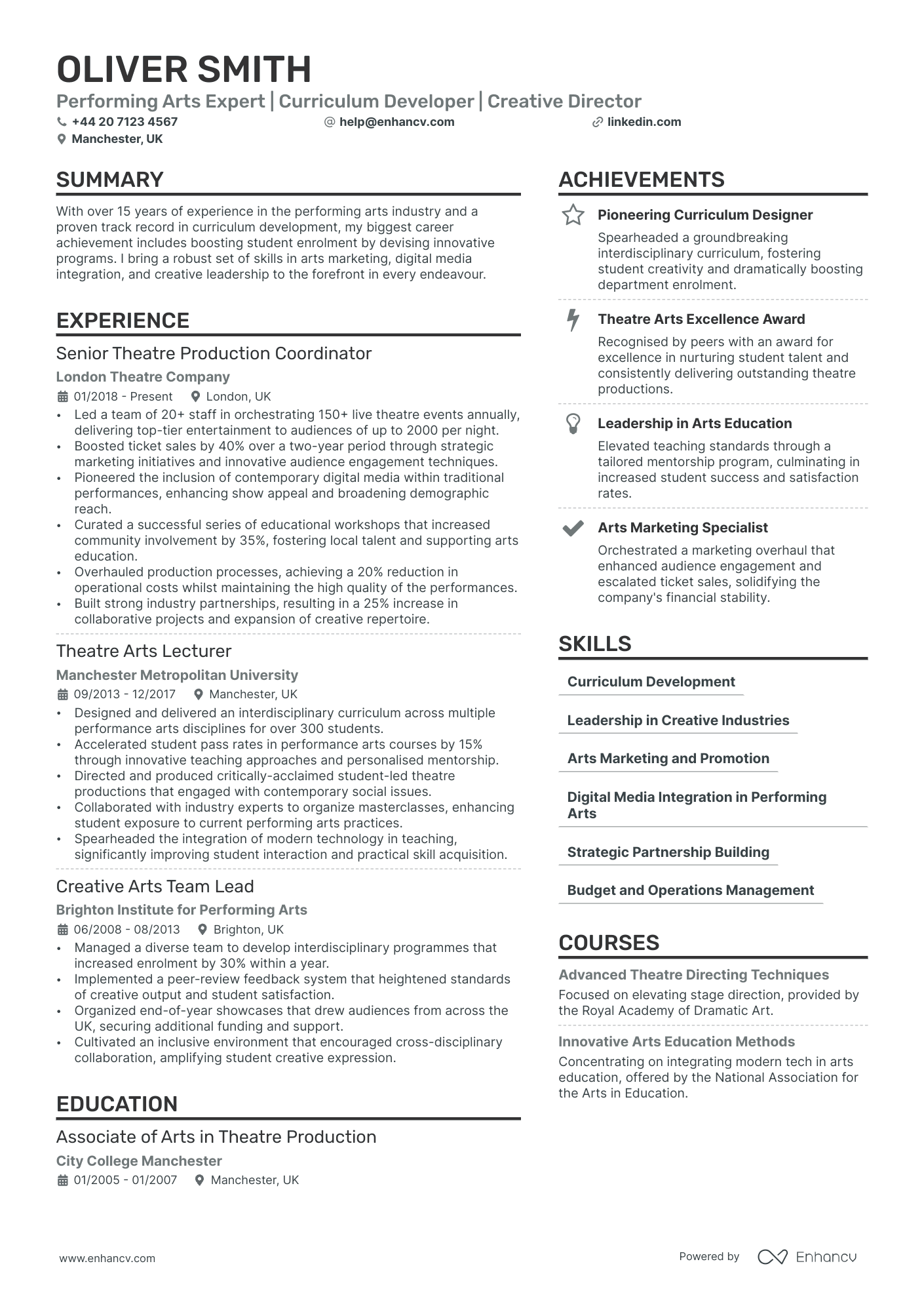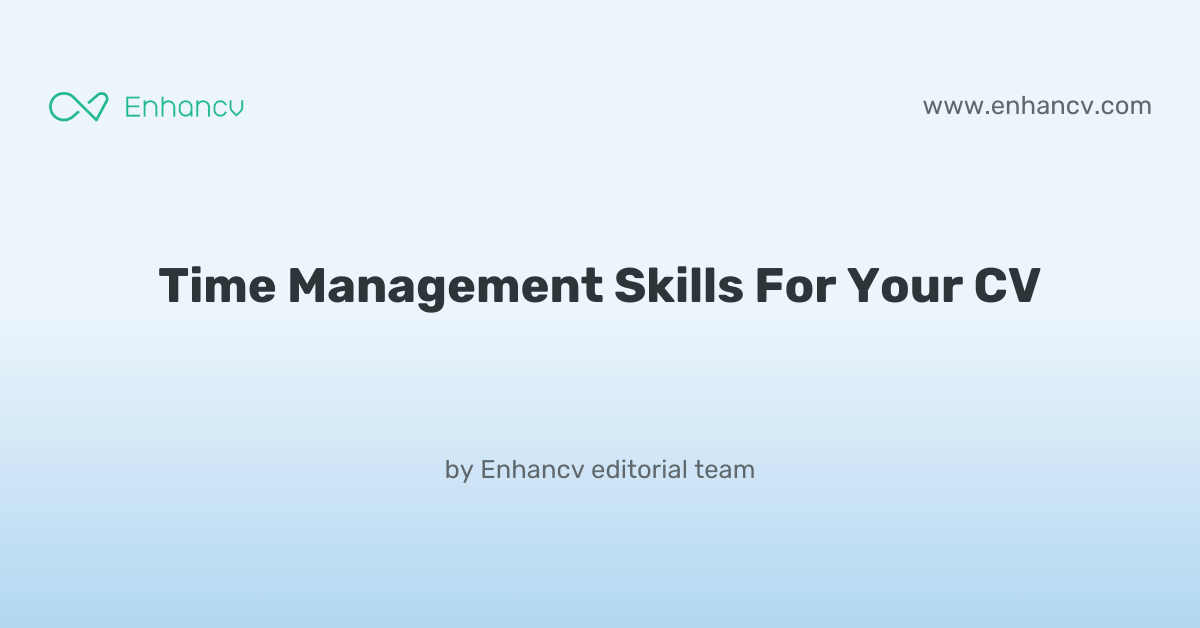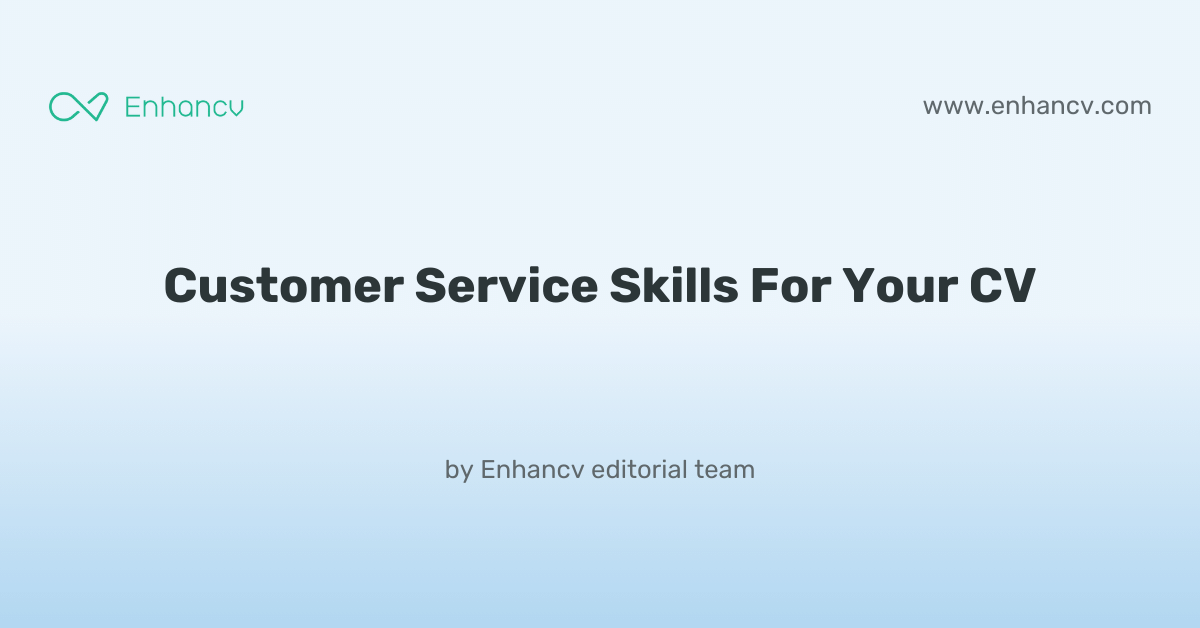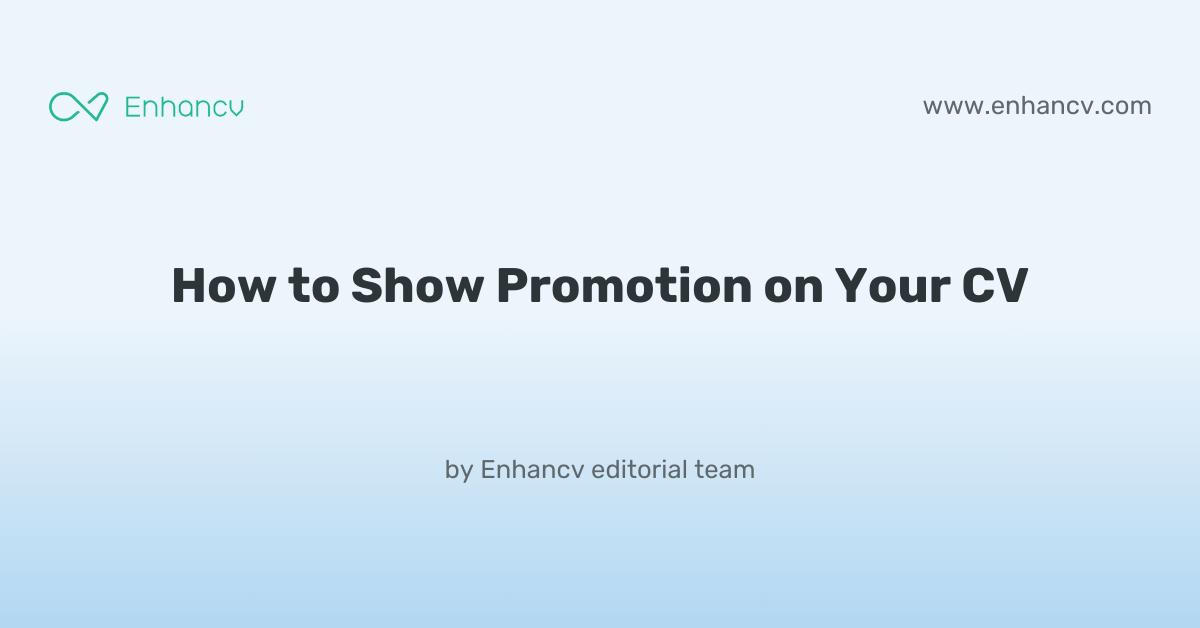One specific CV challenge in the performing arts is differentiating yourself in a dense market of talented performers. Discover how our guide can provide you with the tools to craft a compelling personal narrative and strategic career highlights that resonate with casting directors and agents.
- Applying best practices from real-world examples to ensure your profile always meets recruiters' expectations;
- What to include in your work experience section, apart from your past roles and responsibilities?
- Why are both hard and soft skills important for your application?
- How do you need to format your CV to pass the Applicant Tracker Software (ATS) assessment?
If you're writing your CV for a niche performing arts role, make sure to get some inspiration from professionals:
Structuring and formatting your performing arts CV for an excellent first impression
The experts' best advice regarding your CV format is to keep it simple and concise. Recruiters assessing your CV are foremost looking out for candidates who match their ideal job profile. Your white space, borders, and margins. You may still be wondering which format you need to export your CV in. We recommend using the PDF one, as, upon being uploaded, it never alters your information or CV design. Before we move on to the actual content of your performing arts CV, we'd like to remind you about the Applicant Tracker System (or the ATS). The ATS is a software that is sometimes used to initially assess your profile. Here's what you need to keep in mind about the ATS:- All serif and sans-serif fonts (e.g. Rubik, Volkhov, Exo 2 etc.) are ATS-friendly;
- Many candidates invest in Arial and Times New Roman, so avoid these fonts if you want your application to stand out;
- Both single and double column CVs can be read by the ATS, so it's entirely up to you to select your CV design.
PRO TIP
Incorporate a touch of colour in headers or section breaks, but keep it professional and ensure it doesn’t detract from readability, especially in more conservative industries.
The top sections on a performing arts CV
- Personal Details provide quick access to your contact information.
- Performance Experience shows the depth of your stage work.
- Training and Education displays formal qualifications and development.
- Skills and Abilities highlight your unique performance talents.
- Reviews and Testimonials offer credibility through others’ words.
What recruiters value on your CV:
- Highlight your most prominent performances by naming the production and your role, ensuring that your most recent and relevant experiences in the performing arts are at the forefront.
- Include a detailed skills section that showcases your versatility, including vocal range, dance styles mastered, and any instruments you play, which are critical in the performing arts industry.
- Provide a section for formal training and education, including acting workshops, drama schools attended, or voice coaches, to demonstrate a commitment to professional development within the arts.
- Emphasise any unique talents or performance styles you specialise in, such as physical theatre, mime, or avant-garde performance art, to stand out to casting directors.
- Add a professional headshot and any relevant multimedia materials, such as a link to a showreel, as visuals are powerful in the performing arts and help to create a memorable CV.
Recommended reads:
Our checklist for the must-have information in your performing arts CV header
Right at the very top of your performing arts CV is where you'd find the header section or the space for your contact details, headline, and professional photo. Wondering how to present your the name of the city you live in and the country abbreviation as your address;
- are tailored to the role you're applying for by integrating key job skills and requirements;
- showcase what your unique value is, most often in the form of your most noteworthy accomplishment;
- select your relevant qualifications, skills, or current role to pass the Applicant Tracker System (ATS) assessment. Still not sure how to write your CV headline? Our examples below showcase best practices on creating effective headlines:
Examples of good CV headlines for performing arts:
- "Classical Ballet Dancer | Lead Role in Swan Lake | RAD Certified | 7 Years Experience"
- "Theatre Director | Recently Directed 'Hamlet' | Contemporary & Classic Drama | MA in Directing | 10+ Yrs Exp."
- "Opera Singer | Tenor in 'La Traviata' | Vocal Coach | Languages: IT, FR, DE | 5 Years Professional"
- "Musical Theatre Performer | 'Les Misérables' Ensemble | Triple Threat | West End Experience | 12 Years in Industry"
- "Contemporary Choreographer | 'Re:Birth' latest work | Collaborative Projects | MA Choreography | 8 Yrs Professional"
- "Stage Manager | 'Phantom of the Opera' Production | Technical Direction | BTEC Qualified | 15 Years Expertise"
Opting between a performing arts CV summary or objective
Within the top one third of your performing arts CV, you have the opportunity to briefly summarise your best achievements or present your professional goals and dreams. Those two functions are met by either the CV summary or the objective.
- The summary is three-to-five sentences long and should narrate your best successes, while answering key requirements for the role. Select up to three skills which you can feature in your summary. Always aim to present what the actual outcomes were of using your particular skill set. The summary is an excellent choice for more experienced professionals.
- The objective is more focused on showcasing your unique value as a candidate and defining your dreams and ambitions. Think about highlighting how this current opportunity would answer your career vision. Also, about how you could help your potential employers grow. The objective matches the needs of less experienced candidates, who need to prove their skill set and, in particular, their soft skills.
Still not sure about how to write your CV opening statement? Use some best industry examples as inspiration:
CV summaries for a performing arts job:
- With over a decade of experience on prestigious national stages, this classically trained Shakespearian actor has honed a robust repertoire of dramatic and comedic roles. Notable for a lead performance that garnered critical acclaim at the Royal National Theatre, they possess a commanding stage presence and a dedication to theatrical excellence.
- A veteran choreographer, boasting 15 years of creating groundbreaking dance performances for acclaimed companies such as The Royal Ballet. Skilled in various dance techniques, from ballet to contemporary, they have received numerous accolades for innovative choreography in international dance festivals.
- Award-winning journalist transitioning into playwriting brings a vast experience in crafting compelling narratives. With five years of writing for a major daily newspaper, they aim to meld investigative rigor with dramatic storytelling to create impactful theatrical works that resonate with contemporary audiences.
- A professional orchestral musician with 20 years in symphonies across Europe pivots to musical theatre. They bring unparalleled expertise in musical interpretation, deep understanding of ensemble collaboration, and a proven track record of acclaimed solo performances at venues such as the Berlin Philharmonic.
- Despite a background in software development, personal dedication to the arts has led to a proficient self-taught practice in stage design. Eager to integrate technological innovation with stagecraft, aiming to contribute to the creation of immersive and dynamic stage environments that enhance storytelling.
- Recent drama school graduate with a passion for both avant-garde and commercial theatre, seeks to apply intensive training and a fresh perspective on acting to invigorate performances. Dedicated to lifelong learning and collaboration, this emerging actor is ready to bring dedication and energy to every rehearsal and performance.
Narrating the details of your performing arts CV experience section
Perhaps you've heard it time and time again, but, how you present your experience is what matters the most. Your CV experience section - that details your work history alongside your accomplishments - is the space to spotlight your unqiue expertise and talents. So, avoid solely listing your responsibilities, but instead:
- adverts' keywords and integrate those in your experience section;
- Use your CV to detail how you've been promoted in the past by including experience in the reverse chronological order.
Before you start writing your performing arts CV experience section, dive into some industry-leading examples on how to structure your bullets.
Best practices for your CV's work experience section
- Detail your most prominent roles first, focusing on those that are closest to the position you're applying for, highlighting your versatility and range as a performer.
- Include key performances and projects, specifying the name of the production, your role, the venue, and the director or choreographer to establish credibility.
- Note any standout skills that are pertinent to the role such as singing, dance styles, combat training, or instrument proficiency to demonstrate your multifaceted abilities.
- Quantify your experience where possible, such as the number of performances, audience size, or length of a tour to give context to your level of experience.
- Mention any awards or recognitions received in relation to your performances to showcase your excellence in the field.
- Include positive reviews or quotes from reputable sources or industry professionals that comment on your specific contributions to a project.
- Reference any original works, collaborations, or developments you've contributed to, especially if they demonstrate creativity and thought leadership within your craft.
- Highlight your adaptability by mentioning varied performance contexts, such as theatre, television, film, or live events, showing your ability to transition between different mediums.
- Emphasise rehearsal and performance contributions by describing leadership or mentorship roles, teamwork, and any additional duties you undertook beyond performance.
- Conceived and executed three major performing arts productions each year, managing budgets upwards of $50,000 and delivering performances that sold out consistently.
- Collaborated with a diverse team of directors, choreographers, and designers to create visually compelling and critically acclaimed theatrical experiences.
- Implemented innovative audience engagement strategies, resulting in a 25% increase in subscription sales over a two-year period.
- Orchestrated an interdisciplinary festival featuring over 30 performing artists, dramatically enhancing the cultural offerings of the institution.
- Spearheaded educational outreach programs that connected with local schools, bringing performing arts awareness to over 2,000 students annually.
- Leveraged grant-writing expertise to secure over $100,000 in funding for community-focused performing arts initiatives.
- Introduced cutting-edge technology in stage design, enhancing the visual impact of performances and garnering positive media coverage.
- Cultivated partnerships with local businesses, securing in-kind donations valued at $30,000 to support season programming.
- Developed and administered artist-in-residence programs that supported 15 emerging artists, providing vital opportunities for professional growth.
- Negotiated talent agreements and organized logistics for international theatrical tours, reaching an audience of over 100,000 across 10 countries.
- Supervised a team of 20, ensuring seamless day-to-day operations of the theater, including scheduling, maintenance, and customer service.
- Launched a successful social media marketing campaign that increased online ticket sales by 40% within the first year of implementation.
- Designed comprehensive training programs for actors and stage crew, raising the performance quality and earning recognition in local arts awards.
- Initiated a collaborative project with the local symphony orchestra, resulting in a sold-out performance that blended classical music with contemporary dance.
- Managed casting processes and talent development, successfully attracting high-caliber artists and consistently receiving favorable reviews for casting decisions.
- Oversee the development and implementation of innovative online streaming services for live performances, generating an additional revenue stream during the pandemic.
- Cultivate strong relationships with prominent agents and agencies to attract and retain top-tier talent for leading roles and productions.
- Coordinate with marketing teams to execute promotional campaigns that increased brand visibility and resulted in a 30% boost in audience attendance post-pandemic.
- Managed complex production schedules and coordinated between multiple departments to ensure on-time delivery of 4-6 productions annually.
- Directed successful fundraising campaigns that exceeded financial targets by 15%, enabling the expansion of program offerings.
- Oversaw the renovation of performance spaces, incorporating state-of-the-art lighting and sound systems that enhanced production quality.
- Facilitated workshops and master classes for cast and crew, improving skill levels and fostering a culture of continuous learning and development.
- Developed and executed a strategic plan to expand the educational programming, doubling the number of workshops offered annually.
- Implemented cost-saving measures in set construction without compromising quality, reducing production costs by approximately 20%.
- Designed and supervised the installation of innovative set pieces for 20+ productions, resulting in rave reviews for set design and innovation.
- Negotiated contracts and managed relationships with suppliers, securing high-quality materials while maintaining strict budget control.
- Implemented a mentorship program for young designers, enhancing the skillset of the next generation in the performing arts community.
- Orchestrated and coordinated multiple stage productions simultaneously, seamlessly managing behind-the-scenes activities to ensure flawless performances.
- Streamlined ticketing processes by adopting new software, improving customer experience and increasing advance ticket sales by 35%.
- Cultivated donor relations which resulted in a 50% increase in annual contributions, directly benefiting the theater's endowment fund.
Lacking professional expertise: how to write your CV to highlight your best talents
Don't count on your lucky stars when you're applying for a role, where you happen to have less (or almost none) professional experience. Recruiters sometimes do hire inexperienced candidates if they're able to present their unique value from the get-go. So, instead of opting for the traditional, CV experience section:
- List any applicable expertise you happen to have - no matter if it's a part-time job, internship, or volunteer work. This would hint to recruiters that your profile is relevant;
- Focus your CV on your transferrable skills or talents you've obtained thanks to your whole life and work experience. In effect, you'll be spotlighting your value as a candidate;
- Separate more space for your applicable academic background and certificates to show you have the technical know-how;
- Ensure that within your objective, you've defined why you'll like the job and how you'll be the perfect match for it. Always ensure you've tailored your CV to individual applications.
Looking for more good examples for your first job? We'll show you how other candidates, with less professional experience, have created their job-winning CVs.
Recommended reads:
PRO TIP
Describe how each job helped you grow or learn something new, showing a continuous development path in your career.
Key performing arts CV skills: what are hard skills and soft skills
Let's kick off with the basics. You know that you have to include key job requirements or skills across your CV. For starters, take individual skills from the job description and copy-paste them into your CV, when relevant. Doing so, you'll ensure you have the correct skill spelling and also pass the Applicant Tracker System (ATS) assessment. There are two types of skills you'll need to include on your CV:
- Hard skills - technical abilities that are best defined by your certificates, education, and experience. You could also use the dedicated skills section to list between ten and twelve technologies you're apt at using that match the job requirements.
- Soft skills - your personal traits and interpersonal communication skills that are a bit harder to quantify. Use various CV sections, e.g. summary, strengths, experience, to shine a spotlight on your workspace achievements, thanks to using particular soft skills.
Remember that your job-winning CV should balance both your hard and soft skills to prove your technical background, while spotlighting your personality.
Top skills for your performing arts CV:
Dance Technique
Vocal Training
Acting and Improvisation
Musical Proficiency
Movement Coordination
Script Analysis
Stage Combat Skills
Choreography
Directing
Stage Management
Creativity
Emotional Intelligence
Teamwork
Adaptability
Persistence
Time Management
Critical Thinking
Communication
Resilience
Attention to Detail
PRO TIP
If you have received professional endorsements or recommendations for certain skills, especially on platforms like LinkedIn, mention these to add credibility.
CV education and certificates: your academic background as proof of your skill set
A common misconception about your performing arts CV education is that you only need it, if you have less professional experience. That is completely false. The CV education section serves to back up your technical (and sometimes personal) capabilities, fill in gaps in your work history, and show you have the initial industry background and know-how. When creating your education section:
- List your degrees in the reverse chronological order, starting with the most recent (and relevant) ones first;
- Include your degree and university names, start and graduation dates. It's optional to also denote you received a "First-Class Honours" for diplomas that are more relevant to the role;
- Curate your relevant university coursework, projects, or thesis work if you happen to have less professional expertise and need to integrate more job keywords and skills.
Your professional qualifications don't need to stop at your academic background. It's advisable to also select up to three of your most noteworthy (and relevant) industry certificates and feature them in a dedicated section. Once more, include the certificate name, the institution that issued it out, and the date you obtained it on. You could feature both hard skills and soft skills certificates, as in the examples below:
PRO TIP
If you have received professional endorsements or recommendations for certain skills, especially on platforms like LinkedIn, mention these to add credibility.
Recommended reads:
Key takeaways
Here are five things you need to remember about writing your performing arts CV for success:
- Sort your experience based on the reverse chronological order, starting with your most recent career items, to showcase how you've grown your career;
- Include within your CV header your relevant contact details, a headline that could spotlight your unique value, and a photo - if you're applying for roles outside the UK or US;
- Decide to use the CV summary, if you happen to have more professional experience, and an objective, if you want to showcase your career goals;
- Within the experience section, write your bullets using action verbs, skills, and success, instead of just merely listing your on-the-job responsibilities;
- Prove your technical skills, using your education and certificates, and your soft skills, with your achievements and strengths sections.
